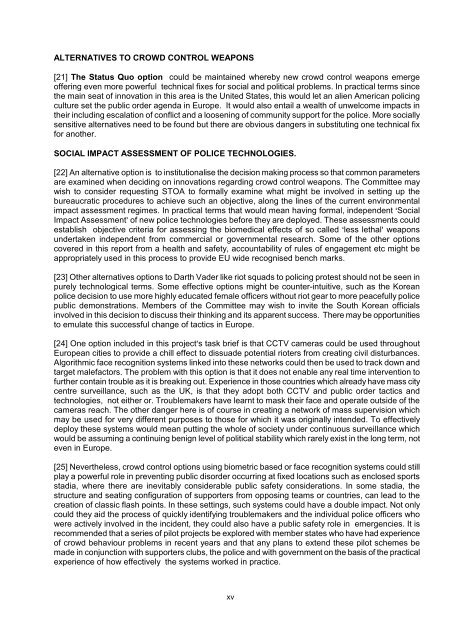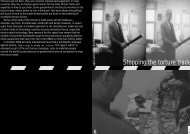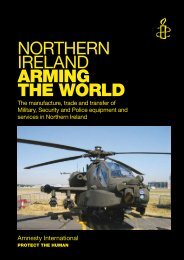CROWD CONTROL TECHNOLOGIES - Omega Research Foundation
CROWD CONTROL TECHNOLOGIES - Omega Research Foundation
CROWD CONTROL TECHNOLOGIES - Omega Research Foundation
You also want an ePaper? Increase the reach of your titles
YUMPU automatically turns print PDFs into web optimized ePapers that Google loves.
ALTERNATIVES TO <strong>CROWD</strong> <strong>CONTROL</strong> WEAPONS<br />
[21] The Status Quo option could be maintained whereby new crowd control weapons emerge<br />
offering even more powerful technical fixes for social and political problems. In practical terms since<br />
the main seat of innovation in this area is the United States, this would let an alien American policing<br />
culture set the public order agenda in Europe. It would also entail a wealth of unwelcome impacts in<br />
their including escalation of conflict and a loosening of community support for the police. More socially<br />
sensitive alternatives need to be found but there are obvious dangers in substituting one technical fix<br />
for another.<br />
SOCIAL IMPACT ASSESSMENT OF POLICE <strong>TECHNOLOGIES</strong>.<br />
[22] An alternative option is to institutionalise the decision making process so that common parameters<br />
are examined when deciding on innovations regarding crowd control weapons. The Committee may<br />
wish to consider requesting STOA to formally examine what might be involved in setting up the<br />
bureaucratic procedures to achieve such an objective, along the lines of the current environmental<br />
impact assessment regimes. In practical terms that would mean having formal, independent Social<br />
Impact Assessment of new police technologies before they are deployed. These assessments could<br />
establish objective criteria for assessing the biomedical effects of so called less lethal weapons<br />
undertaken independent from commercial or governmental research. Some of the other options<br />
covered in this report from a health and safety, accountability of rules of engagement etc might be<br />
appropriately used in this process to provide EU wide recognised bench marks.<br />
[23] Other alternatives options to Darth Vader like riot squads to policing protest should not be seen in<br />
purely technological terms. Some effective options might be counter-intuitive, such as the Korean<br />
police decision to use more highly educated female officers without riot gear to more peacefully police<br />
public demonstrations. Members of the Committee may wish to invite the South Korean officials<br />
involved in this decision to discuss their thinking and its apparent success. There may be opportunities<br />
to emulate this successful change of tactics in Europe.<br />
[24] One option included in this projects task brief is that CCTV cameras could be used throughout<br />
European cities to provide a chill effect to dissuade potential rioters from creating civil disturbances.<br />
Algorithmic face recognition systems linked into these networks could then be used to track down and<br />
target malefactors. The problem with this option is that it does not enable any real time intervention to<br />
further contain trouble as it is breaking out. Experience in those countries which already have mass city<br />
centre surveillance, such as the UK, is that they adopt both CCTV and public order tactics and<br />
technologies, not either or. Troublemakers have learnt to mask their face and operate outside of the<br />
cameras reach. The other danger here is of course in creating a network of mass supervision which<br />
may be used for very different purposes to those for which it was originally intended. To effectively<br />
deploy these systems would mean putting the whole of society under continuous surveillance which<br />
would be assuming a continuing benign level of political stability which rarely exist in the long term, not<br />
even in Europe.<br />
[25] Nevertheless, crowd control options using biometric based or face recognition systems could still<br />
play a powerful role in preventing public disorder occurring at fixed locations such as enclosed sports<br />
stadia, where there are inevitably considerable public safety considerations. In some stadia, the<br />
structure and seating configuration of supporters from opposing teams or countries, can lead to the<br />
creation of classic flash points. In these settings, such systems could have a double impact. Not only<br />
could they aid the process of quickly identifying troublemakers and the individual police officers who<br />
were actively involved in the incident, they could also have a public safety role in emergencies. It is<br />
recommended that a series of pilot projects be explored with member states who have had experience<br />
of crowd behaviour problems in recent years and that any plans to extend these pilot schemes be<br />
made in conjunction with supporters clubs, the police and with government on the basis of the practical<br />
experience of how effectively the systems worked in practice.<br />
xv




